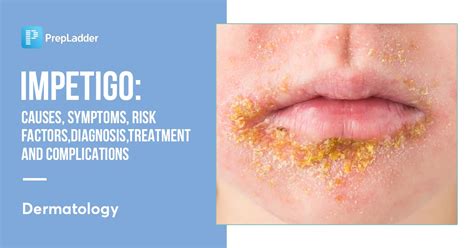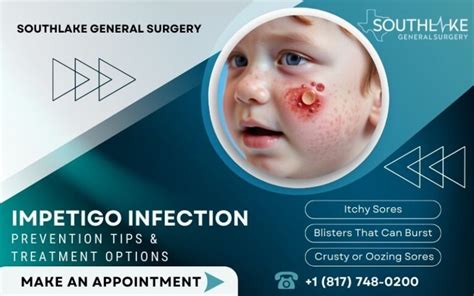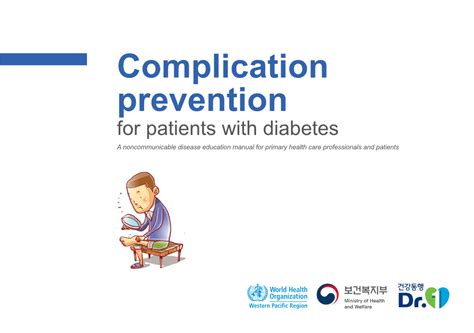Intro
Discover effective impetigo treatment options, including antibiotics, creams, and home remedies, to combat bacterial skin infections, promoting healthy skin and preventing contagion with topical, oral, and natural therapies.
Impetigo is a highly contagious skin infection that affects millions of people worldwide. It is characterized by red sores on the face, especially around the nose and mouth, and can spread to other parts of the body via touch, clothing, or other items that come into contact with the affected area. The importance of treating impetigo cannot be overstated, as it can lead to more serious complications if left untreated. In this article, we will delve into the various impetigo treatment options available, exploring their benefits, working mechanisms, and potential side effects.
Impetigo is often caused by bacterial infections, typically Staphylococcus aureus or Streptococcus pyogenes. The infection can be spread through skin-to-skin contact, contaminated items, or poor hygiene. Symptoms of impetigo include red, itchy, and inflamed skin, which can eventually develop into blisters or sores. If you suspect you or a family member has impetigo, it is essential to seek medical attention to prevent the infection from spreading and to receive proper treatment.
The good news is that impetigo is highly treatable, and with the right treatment, most people can recover within a week or two. Treatment options for impetigo typically involve antibiotics, either topical or oral, depending on the severity of the infection. In addition to antibiotics, there are several home remedies and self-care practices that can help alleviate symptoms and support the healing process. In the following sections, we will explore these treatment options in more detail, including their benefits, potential side effects, and what to expect during the treatment process.
Understanding Impetigo

Causes and Risk Factors
Impetigo is often caused by Staphylococcus aureus or Streptococcus pyogenes bacteria. These bacteria can enter the body through cuts, scrapes, or other breaks in the skin. Risk factors for impetigo include poor hygiene, crowded living conditions, and compromised immune systems. Individuals with skin conditions like eczema or psoriasis are also more susceptible to impetigo.Treatment Options for Impetigo

Topical Antibiotics
Topical antibiotics are creams or ointments applied directly to the affected area. They are usually effective for mild cases of impetigo and can help reduce the risk of spreading the infection. Common topical antibiotics for impetigo include mupirocin, fusidic acid, and retapamulin. These antibiotics work by killing the bacteria that cause impetigo, reducing inflammation and promoting healing.Oral Antibiotics
Oral antibiotics may be necessary for more severe cases of impetigo or when the infection has spread to other parts of the body. Common oral antibiotics for impetigo include amoxicillin, clindamycin, and cephalexin. These antibiotics work by killing the bacteria that cause impetigo, reducing inflammation and promoting healing. However, oral antibiotics can have potential side effects, such as stomach upset, diarrhea, and allergic reactions.Home Remedies and Self-Care Practices

Keeping the Affected Area Clean and Dry
Keeping the affected area clean and dry is crucial for promoting healing and preventing the spread of the infection. This can be achieved by gently washing the area with soap and water, patting it dry with a clean towel, and applying a topical antibiotic cream or ointment. It is also essential to keep the area covered with a bandage or dressing to prevent scratching or picking at the sores.Applying Cool Compresses
Applying cool compresses to the affected area can help reduce itching and inflammation. This can be achieved by soaking a clean cloth in cool water, wringing it out, and applying it to the affected area for 15-20 minutes. Cool compresses can be repeated several times a day to provide relief and promote healing.Prevention and Complications

Practicing Good Hygiene
Practicing good hygiene is essential for preventing impetigo. This includes washing hands regularly, especially after touching the affected area, and avoiding sharing personal items, such as towels, clothing, or utensils. It is also essential to keep the affected area clean and dry, and to avoid touching or scratching the sores.Avoiding Touching or Scratching the Sores
Avoiding touching or scratching the sores is crucial for preventing the spread of the infection. This can be achieved by keeping the affected area covered with a bandage or dressing, and avoiding touching or scratching the sores. It is also essential to wash hands regularly, especially after touching the affected area, to prevent the spread of the infection.Conclusion and Next Steps

We invite you to share your thoughts and experiences with impetigo in the comments section below. Have you or a family member been diagnosed with impetigo? What treatment options did you use, and what were the results? Your feedback and insights can help others who may be struggling with this common skin infection. Additionally, if you have any questions or concerns about impetigo, please do not hesitate to ask, and we will do our best to provide you with accurate and helpful information.
What are the symptoms of impetigo?
+Impetigo is characterized by red, itchy, and inflamed skin, which can eventually develop into blisters or sores. The infection can spread to other parts of the body via touch, clothing, or other items that come into contact with the affected area.
How is impetigo treated?
+Impetigo is typically treated with antibiotics, either topical or oral, depending on the severity of the infection. In addition to antibiotics, there are several home remedies and self-care practices that can help alleviate symptoms and support the healing process.
Can impetigo be prevented?
+Yes, impetigo can be prevented by practicing good hygiene, such as washing hands regularly and avoiding sharing personal items. It is also essential to avoid touching or scratching the sores, as this can spread the infection to other parts of the body.
What are the potential complications of impetigo?
+If left untreated, impetigo can lead to more serious complications, such as cellulitis, abscesses, or even sepsis. It is essential to seek medical attention if symptoms persist or worsen over time.
How long does it take to recover from impetigo?
+Most people can recover from impetigo within a week or two with proper treatment. However, the recovery time may vary depending on the severity of the infection and the effectiveness of the treatment.
